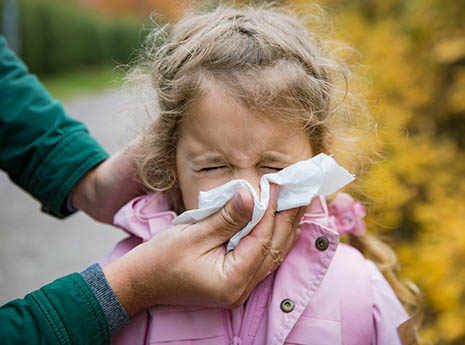September 18, 2024
Flu Season is Here: What You Need to Know About the Upcoming Virus Season
Fall is full of excitement—Back-to-School buzz, Halloween thrills, and cozy family moments. But there's one uninvited guest we can’t forget: The Flu! Let’s remember to stay protected and healthy.

Let’s Talk About In(flu)enza:
Influenza, better known as The Flu, is a respiratory sickness that can be often mistaken as a common cold. Like most viruses, influenza has different strains or types that stem from the virus. Influenza has four! The two types that we should pay attention to are Influenza A and B. Why? These two types, A and B, are primarily responsible for what we hear called “the flu season”. Influenza is contagious and can spread person to person. Now, let’s dive into some more helpful information about the flu.
Is the Flu Seasonal?
Ever heard someone say, “Everyone’s got a cold—it must be flu season”? Well, that’s because the flu does have a season! While the flu virus is around all year, it’s most active during the fall and winter months. According to the CDC, flu cases start to rise in October and hit their peak between December and February. So yes, flu season is real! This is the time of year when we need to be extra careful and take steps to stay healthy. In the San Francisco Bay Area our flu season is heavily influenced by travel during the holiday season, Thanksgiving to New Years. People from colder climates where the flu season has already kicked in often travel to their families in the Bay Area. Consequently our flu season frequently begins over the holidays and peaks shortly after our holiday season has concluded.

What can you do to protect yourself?
The best way to protect your kids and family from the flu is by getting the flu vaccine! Shots might seem scary, but they’re here to help keep us safe. What does the shot do? Does the flu shot give you the flu? When you get the influenza vaccine, it helps your body build antibodies that fight off the influenza virus . Once the vaccine is in your system it takes up to 2 weeks for it to kick in and protect you from the flu. It does not give you the virus, it only gives you antibodies to fight the virus off! Here’s what you should know:
- While the flu shot is the most effective way to prevent getting the virus, if you do catch it, the vaccine is designed to reduce how severe your illness is. Each year, it prevents millions of flu cases, flu hospitalizations, and deaths, even in kids!
- It’s recommended to get your flu shot once a year. So, at your next doctor’s appointment, don’t forget to ask for it—or take the first step by calling and scheduling your flu vaccine today!
- Anyone that is 6 months or older can receive the flu shot annually.
- If you do get the flu…your doctor can prescribe medication that can shorten the duration & severity of the illness. In order for the medication to be effective it must be prescribed within the first two days.

The flu shot can be life saving and it could prevent you from getting the virus this upcoming season!
Day-to-Day Preventive Actions
- Keep a safe distance from those who are sick and if you happen to become sick, limit your contact with others!
- Practice clean air circulation in enclosed spaces. Open windows, purchase an air purifier, or even take a few moments outdoors to breathe in the crisp fall air.
- Cover your coughs and sneezes. Remember it’s important to cover the nose and mouth. Let’s not spread germs!
- Always wash your hands for at least 30 seconds. Unlike COVID, the flu and the common cold can be transmitted through surfaces.
- Lucky for us, there are antiviral sprays available to purchase to help protect us from these contagious surfaces.
Differences Between a Common Cold vs The Flu
The influenza virus can bring a range of symptoms—from coughs, sore throats or severe fever. And for young kids and our older loved ones, it can be especially risky. How do you know if it’s just a cold or something more? Knowing the difference between a common cold and the flu is key to keeping everyone safe and healthy. Check out the chart below to spot the differences!
| SIGNS AND SYMPTOMS | COLD | FLU |
| Symptom Onset | Gradual | Abrupt |
| Fever | Rare | Usual |
| Aches | Slight | Usual |
| Chills | Uncommon | Fairly common |
| Fatigue, Weakness | Sometimes | Usual |
| Sneezing | Common | Sometimes |
| Chest discomfort, cough | Mild to moderate | Common |
| Stuffy Nose | Common | Sometimes |
| Sore Throat | Common | Sometimes |
| Headache | Rare | Common |
COVID-19 vs The Flu: Is there a Difference?
Since the start of the COVID-19 pandemic, telling the difference between the flu and coronavirus has become trickier. But here’s the simple truth: they’re not the same! Both viruses share a lot of similar symptoms, making it tough to figure out which one you have based on symptoms alone. So, let’s break it down and take a look at the symptoms they have in common:
| Fever | Body aches or chills | Sore throat |
| Cough | Shortness of breath | Headache |
| Runny or Stuffy nose | Fatigue | Nausea or vomiting |
Want to make sure you’re taking the right steps if you catch one of these illnesses? The best thing you can do is take a test! Luckily, there are tests available for both the flu and COVID-19 to help you know exactly what you’re dealing with and how to handle it. Similarly to the flu, there’s medication available for Covid-19. Make sure to ask your doctor if you think you have Covid.
Sources:
https://www.cdc.gov/flu/prevent/vaccine-benefits.htm
https://www.cdc.gov/flu/about/season/index.html
https://www.cdc.gov/flu/prevent/misconceptions.htm
https://www.mayoclinic.org/diseases-conditions/coronavirus/in-depth/coronavirus-vs-flu/art-20490339
